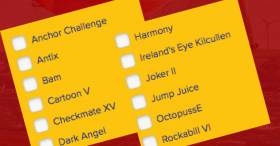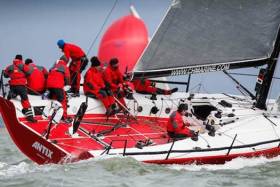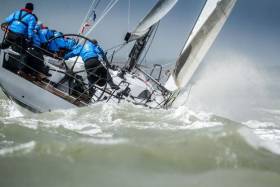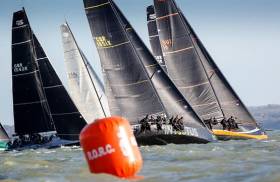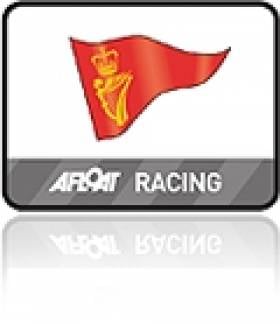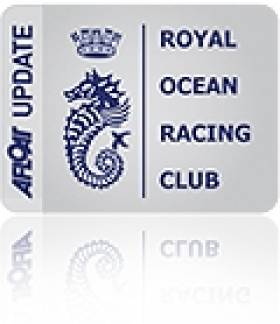Displaying items by tag: antix
Anthony O'Leary's Antix crew from Royal Cork Yacht Club maintain their lead after five races sailed at the Cape 31 Irish Nationals at Volvo Dun Laoghaire Regatta.
Antix, who were the UK's top Corinthian Cape 31 crew at Royal Lymington in June, counted a win in race four followed by a third place this afternoon in the six-boat fleet that they are discarding to be two points clear going into Sunday's final races.
Howth's Dan O'Grady sailing Aja has been overtaken for second place by Mike Bartholomew's Tokoloshe who sits on eight points.
Racing was postponed for one hour on the penultimate day to allow strong winds to abate, a decision that proved correct as Dublin Bay yielded perfect summer sailing conditions in the afternoon.
The breeze was in a south-westerly direction at 15 knots, with some strong gusts and big wind shifts off the Blackrock shoreline to make for some exciting racing on the South Bull course.
The 2023 regatta, the ninth edition of Ireland's largest sailing event, concludes on Sunday with two final races for most classes and a great festival of sailing across the waterfront and Dun Laoghaire town as four sailing clubs come together for the biennial event; Dun Laoghaire Motor Yacht Club, Royal Irish Yacht Club, Royal St. George Yacht Club and National Yacht Club.
Results are provisional and subject to protest.
O'Leary's Antix Has the Advantage in the Cape 31 Nationals at Volvo Dun Laoghaire Regatta
The O'Leary Antix crew defending their Irish crown in style after the first day of racing in tough Dublin Bay conditions at the Cape 31 Irish Nationals at Volvo Dun Laoghaire Regatta.
Antix, who were the UK's top Corinthian Cape 31 crew at Royal Lymington in June, are counting a 2,2,1 to be on five points and three points clear of Howth's Dan O'Grady sailing Aja.
 Howth Yacht Club's Aja skippered by Dan O'Grady Photo: Michael Chester
Howth Yacht Club's Aja skippered by Dan O'Grady Photo: Michael Chester
Lying third in the six-boat fleet is Mike Bartholomew's Tokoloshe, the winner of the Cape 31 Class at the 2022 RORC Vice Admiral's Cup, is also on eight.
 Mike Bartholomew's Tokoloshe Photo: Michael Chester
Mike Bartholomew's Tokoloshe Photo: Michael Chester
The strong southerly winds are expected to continue for Saturday's races before moderating for Sunday's conclusion of the biennial event.
The Dun Laoghaire Motor Yacht Club, National Yacht Club, Royal Irish Yacht Club, and Royal St. George Yacht Club are organising the ninth regatta.
ICRA’s 'Boat Of The Year'? You Choose
The Annual Conference of the Irish Cruiser Racer Association (ICRA), an absorbing all-day affair in Limerick this Saturday (March 4th), has an intriguing agenda writes W M Nixon. But for many sailors from all over Ireland and the other side of the Irish Sea, the high point of it all will be the announcement of the ICRA “Boat of the Year” selected by the ICRA judges.
We revive memories of the great year of 2016 by running our own informal poll - just click as you wish on this alphabetic list at the bottom of this story to see whose achievements rise up the ranking. We can only say that that the wealth of choice speaks highly of the great good health and re-growing popularity of “waterborne truck racing”
 QUARTER TONNER Anchor Challenge – Paul Gibbons from Royal Cork Yacht Club. Photo: Bob Bateman
QUARTER TONNER Anchor Challenge – Paul Gibbons from Royal Cork Yacht Club. Photo: Bob Bateman
Anchor Challenge: Paul Gibbon’s classic Quarter Tonner from Crosshaven was good on enthusiasm, and good on performance, her top line being the overall win in the IRC Europeans at Crosshaven in July, which he plans to defend at Marseilles this summer.
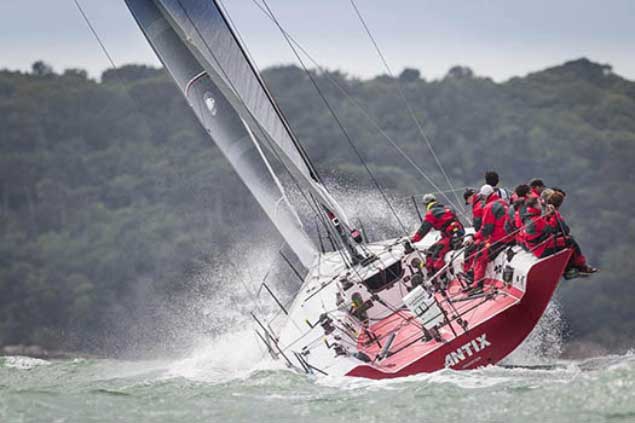 KER39 Antix – Anthony O'Leary from Royal Cork Yacht Club. Photo: Paul Wyeth
KER39 Antix – Anthony O'Leary from Royal Cork Yacht Club. Photo: Paul Wyeth
Antix: Anthony O’Leary’s Fast Forty+ may not have had her most successful season ever in 2016, but many crews would give their eye teeth to have a record as good, topped with the Class O win in the IRC Europeans in Cork Harbour in July.
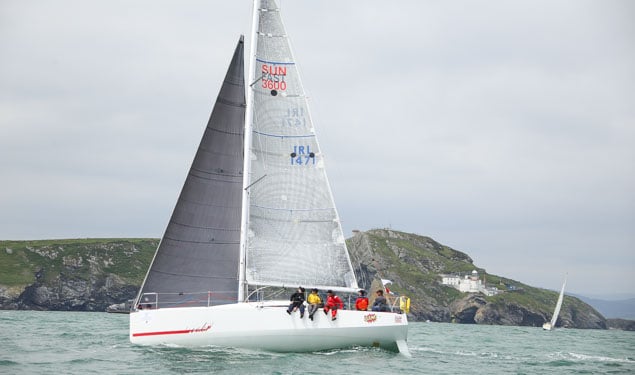 SUNFAST 3600 BAM! - Conor Fogerty from Howth Yacht Club. Photo: Afloat.ie
SUNFAST 3600 BAM! - Conor Fogerty from Howth Yacht Club. Photo: Afloat.ie
Bam!: With the complexities of the RORC Caribbean 2017 still fresh upon us, we realize just how good was Conor Fogerty’s Class win in 2016 in this demanding maze of a race around the islands with his Sunfast 3600 Bam!. And on top of that, it was all just part of an extraordinary season with thousands and thousands of miles of sailing and racing
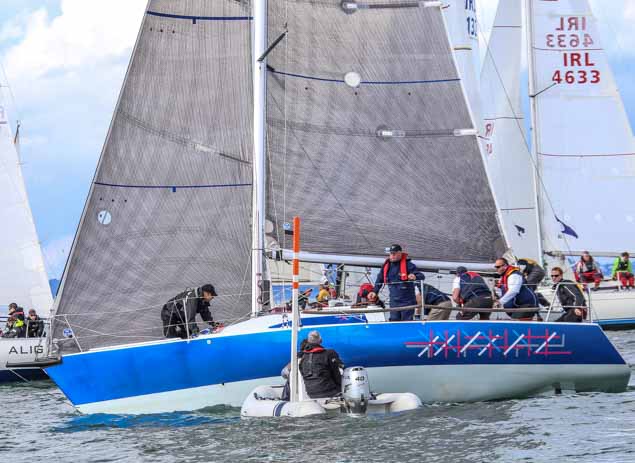 HALF TONNER Checkmate XV – David Cullen from Howth Yacht Club. Photo: Afloat.ie
HALF TONNER Checkmate XV – David Cullen from Howth Yacht Club. Photo: Afloat.ie
Checkmate XV: David Cullen’s beautifully-presented classic Half Tonner Checkmate XV found form to rocket to the top in the ICRA Nats at his home port of Howth in June in a very convincing style. Dave also skippered the J/109 Storm to a class win in the Volvo Round Ireland as Euro Carparks, but maybe that should count as a success for the Kelly family’s Storm, which also won the J/109 Nationals
 QUARTER TONNER Cartoon – Ken Lawless & Sybil McCormack from the Royal Irish Yacht Club. Photo: Afloat.ie
QUARTER TONNER Cartoon – Ken Lawless & Sybil McCormack from the Royal Irish Yacht Club. Photo: Afloat.ie
Cartoon V: Ken Lawless & Sybil McCormack (RIYC) with their characterful Quarter Tonner came sweeping through the IRC Nationals to win their class in style.
 DUBOIS 37 Dark Angel – Tony Ackland from Swansea. Photo: Bob Bateman
DUBOIS 37 Dark Angel – Tony Ackland from Swansea. Photo: Bob Bateman
Dark Angel: Tony Ackland from Swansea turned all heads with his handsome boat which in a previous life was well known in both Cork Harbour and Galway. There’s more than just looks to the Angel – she won IRC 1 in the Europeans at Crosshaven.
 HALF TONNER Harmony – Jonny Swan from Howth Yacht Club. Photo: Bob Bateman
HALF TONNER Harmony – Jonny Swan from Howth Yacht Club. Photo: Bob Bateman
Harmony: Jonny Swan’s wooden-built classic Half Tonner Harmony benefitted from an under-deck laminated fore-and-aft girder installed by Dougal McMahon of Belmont in County Offaly literally to provide a bit of backbone, and it worked a treat. In many victories, Harmony won IRC 3 in the Europeans at Cork.
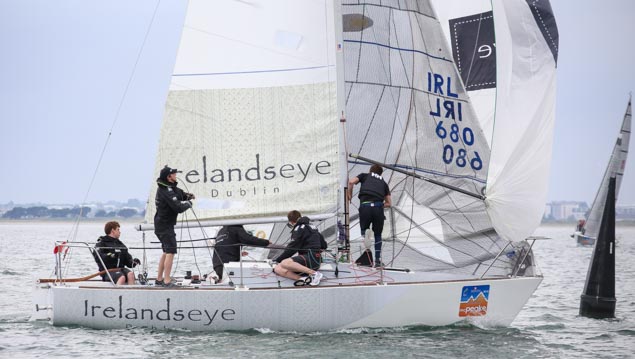 J24 Ireland's Eye Kilcullen – HYC under-25s from Howth Yacht Club
J24 Ireland's Eye Kilcullen – HYC under-25s from Howth Yacht Club
Ireland’s Eye Kilcullen: The HYC nippers – aka the under-25s – in the club-backed J/24 showed there’s still life in this classic Johnstone design. In open events they took second place in Class 4 at Cork Week and the IRC Europeans, they also took third overall in the J/24 Under 25 Europeans. And in the class in Ireland they won the Nationals (7 wins in 7 races), the Northerns, the Southerns, and the Westerns.
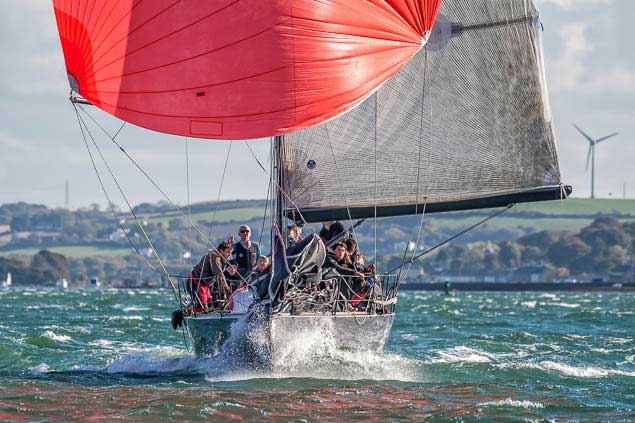 KER36 Jump Juice - Conor Phelan from Royal Cork Yacht Club. Photo: Bob Bateman
KER36 Jump Juice - Conor Phelan from Royal Cork Yacht Club. Photo: Bob Bateman
Jump Juice: Like good wine, Conor Phelan’s Ker 36 from Cork improves with age. They won the RORC Easter Challenge in ferocious weather in the Solent overall, and they won Class O in convincing style at the ICRA Nats in June.
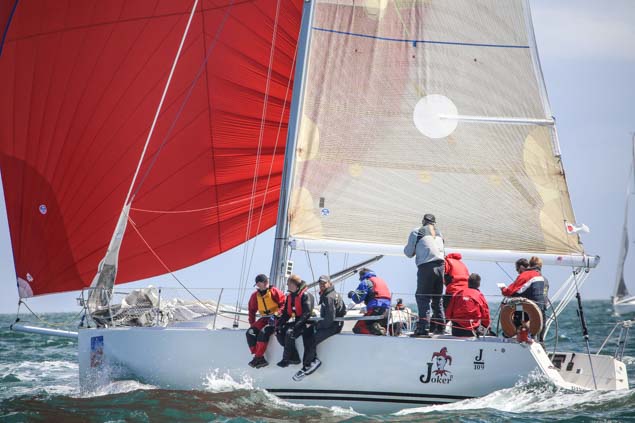 J109 Joker 2 - John Maybury from the Royal Irish Yacht Club. Photo: Afloat.ie
J109 Joker 2 - John Maybury from the Royal Irish Yacht Club. Photo: Afloat.ie
Joker 2: If you wanted a demonstration of the J/109’s all round ability, John Maybury’s Joker 2 provided it in 2016. She recorded a back-to-back win in the ICRA Nats – the only boat to do so in 2015-2016 – and under the skippering of Commandant Barry Byrne, she was the first winner of the new inter-forces Beaufort Cup including winning its Fastnet Race. Same boat, but completely different crews – Joker 2 makes a special claim for top boat of the year
 E–BOAT OctopussE - Pat O’Neill from Clontarf Yacht & Boat Club. Photo: Afloat.ie
E–BOAT OctopussE - Pat O’Neill from Clontarf Yacht & Boat Club. Photo: Afloat.ie
OctopussE: The Julian Everitt-designed E Boat is a blast from the past, a miniature offshore racer in which the vertical keel can be retracted completely into the hull. The fleet at Clontarf deserve every credit for their multiple use, including club racing and canal cruising. But it is Pat O’Neill who carries it all through with competition in the ICRA Nats, and he won IRC 4.
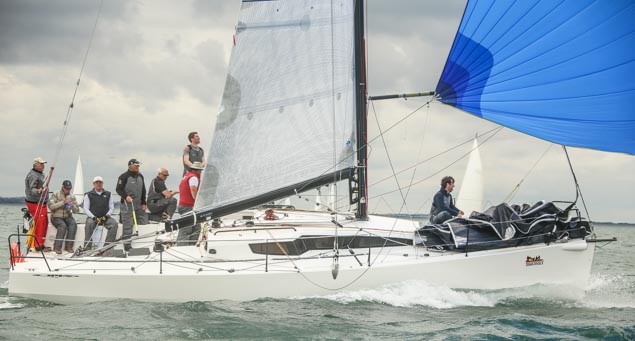 JPK 10.80 Rockabill – Paul O'Higgins from the Royal Irish Yacht Club. Photo: Afloat.ie
JPK 10.80 Rockabill – Paul O'Higgins from the Royal Irish Yacht Club. Photo: Afloat.ie
Rockabill VI: It takes courage to start racing in a boat with a massive international success record like the JPK 10.80, but Paul O’Higgins was game for the challenge when he took Rockabill VI fresh out of the wrappings to do the Volvo Round Ireland Race in June, and came within an ace of a class win. He then re-surfaced for the IRC Europeans at Cork in July – and won IRC 2.
- Votes: (0%)
- Votes: (0%)
- Votes: (0%)
- Votes: (0%)
- Votes: (0%)
- Votes: (0%)
- Votes: (0%)
- Votes: (0%)
- Votes: (0%)
- Votes: (0%)
- Votes: (0%)
- Votes: (0%)


| Total Votes: | |
| First Vote: | |
| Last Vote: |
Update: Royal Cork's Ker 40 Antix (ex-Catapult)
Technical gremlins caused Antix to be advertised 'in error' last Friday on the Ancasta boat sales site. The Irish Commodore's Cup winning yacht is not for sale on its website, yacht brokers Ancasta have confirmed to Afloat.
Royal Cork Yacht Club's Jump Juice (Conor Phelan) has won the 17–boat class two fleet of RORC's Easter Challenge on the Solent today in dramatic fashion. Clubmate Antix (Anthony O'Leary) at the helm of Antix was the winner of today's breezy FAST 40+ race but the Royal Cork yacht did not retain the overall trophy won in 2015 and finished fourth overall.
If traditionally the RORC Easter Challenge is the Royal Ocean Racing Club's coaching regatta, today's lesson centred upon heavy weather sailing technique.
As the fleet returned to yesterday's start area around Peel Bank, conditions were sunny and relatively benign, but with giant grey clouds looming. During today's one race, a squall stuck down the fleet with gale force gusts of up to 40 knots. In addition to numerous broaches, there were two man overboard incidents; one on James Neville's INO XXX racing in the FAST 40+ class, the other on RORC Admiral Andrew McIrvine's First 40, La Réponse.
On La Réponse the vang trimmer got washed overboard during a Chinese gybe. As McIrvine described it: "We were absolutely dead downwind and a little bit by the lee and a big gust took us the other way. We let the vang off too much and the boat rolled and we Chinesed in."
Fortunately the MOB's lifejacket inflated and they were recovered after a few minutes and hauled onto a RIB by RORC Commodore Michael Boyd and lead coach, Jim Saltonstall. The incident cost La Réponse victory in IRC Two, where today's race was claimed by former RORC Commodore Mike Greville on his Ker 39 Erivale III and the class prize went to Ireland's Conor Phelan and his Ker 37, Jump Juice.
Phelan described today: "We were happy to pull it off because the conditions were quite challenging." During the race they saw 35 knots. "I thought we were going to go down the mine on the run," said tactician Mike Budd. "We had to drop the kite and do two gybes at the bottom which was a bit wild but our main competitor [La Réponse] span out at that point which was bad luck to them because they sailed well."
With the big forecast, eight of the 10 FAST40+ class pitched up today but only four finished. While James Neville's INO XXX got away well at the pin, Mike Bartholomew's Tokoloshe II did well being first to hoist her kite. However the South Africans subsequently struggled to retrieve their kite causing it to fly like a flag from the masthead. Eventually the crew relinquished, performing a 'chase boat drop' with the assistance of RORC CEO Eddie Warden Owen.
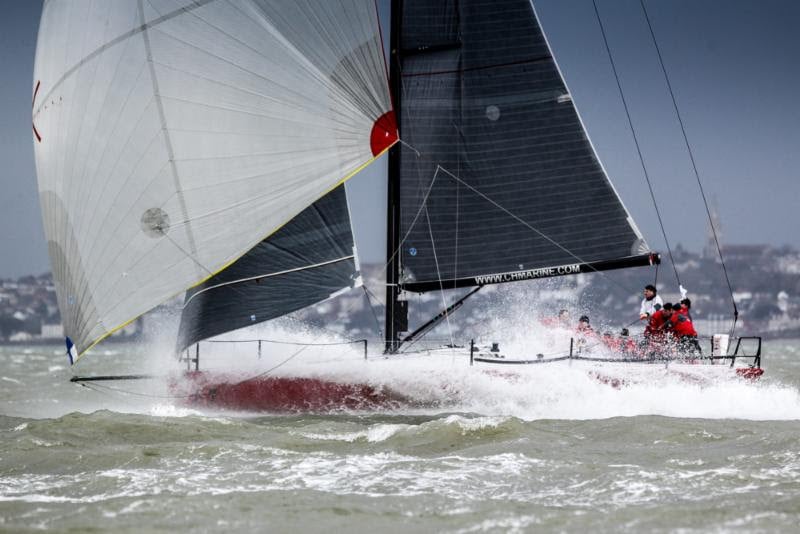
Anthony O'Leary's Antix at full speed on the Solent this afternoon. Photo: Paul Wyeth
Today's FAST 40+ race was won by Anthony O'Leary's Ker 40, Antix. For the Irish two time Brewin Dolphin Commodores' Cup winner, this event was their first sailing this season. However O'Leary acknowledged that Antix prefers the big conditions. "Pound for pound, we sail better in a gale than in a calm." However, in similar conditions, they had finished fourth in yesterday's race. "We made some silly mistakes and you deserve to get punished for that. Our mark rounding was getting better as the weekend went on."
Ultimately Texan William Coates' Ker 43 Otra Vez was the overall winner of the FAST40+ class' first ever regatta. Peter Morton's Carkeek 40 Mk3 Girls on Film didn't compete today leaving Sir Keith Mills' Ker 40+ Invictus to take second overall.
Mills stated: "We saw 37 knots of wind and then various things started blowing away and we had a wonderful broach, when we nearly lost one of our guys over the side. We hit something like 23-24 knots downwind, but I had so much water in my face that I couldn't see the instruments. You need a snorkel and goggles! They are wet boats but such great fun to sail. My boat is like racing a dinghy."
Despite a strong challenge from David Franks' JPK 10.10 Strait Dealer, which claimed three bullets in five races, it was the newer, larger JPK 10.80 Sunrise that prevailed in IRC Three, winning today's race.
"This is the first time I have won a yacht race - which is why we're drinking at 1100!" enthused Sunrise's skipper, Tom Kneen. "We've only had the boat for four weeks and she's just astonishing - very very fast and in quite difficult conditions."
Kneen experienced his first Chinese gybe yesterday, but today calmed down, which he attributed to the coaching they received yesterday. "That was very useful - about moving our weight around the boat which makes such a difference. The whole process of this weekend has enabled us to build, so I am looking forward to the season."
In IRC Four Harry Heijst and his Winsome claimed today's race and the overall class win. The conditions over the Easter weekend perfectly suited the classic Dutch S&S 41. One of the most impressive performances in IRC Four was that of the Sam Laidlaw-helmed Quarter Tonner, Aguila. "It is a real handful and very hard to get uphill because you are almost overpowered," said Laidlaw of sailing the mini boat in the big wind. "It was gusting 35-38 knots, but we were planning at 16!"
Quarter Tonners aren't supposed to plane? "Someone forgot to tell the boat that! We got to the bottom of the run and all we could see was white water everywhere. We had a great time - great fun."
Racing Manager, Nick Elliott concluded: "While conditions were challenging over the regatta, this provided the perfect opportunity to gain valuable experience from our world class coaches and will certainly have jump started each participant's season."
Royal Cork's Jump Juice Lying Second in RORC Easter Challenge
High speed, adrenalin pumping, ultra-competitive racing came to the Solent on the first day of RORC's Easter Challenge 2016 in what many agree is the most exciting development to have taken place in big boat keel boat racing in the UK for decades writes James Boyd.
The long-awaited advent of competition for the new FAST40+s, the big boat class at the Royal Ocean Racing Club's Easter Challenge, coincided today with chilly, but summery conditions. Three races were sailed with the wind peaking at 15-20 knots during race two. Royal Cork's Antix scored a 9,8,4 to be eighth overall in a fleet of ten.
Among the ten FAST40s, there was a different winner in each race, but ultimately there were two stand-out performers in American William Coates' Ker 43, Otra Vez, and Peter Morton's brand new Carkeek 40 Mk3, Girls on Film. They won the third and first races, respectively, while Sir Keith Mills' Ker 40+, Invictus, claimed race two when the FAST40+s were sailing at wind speed.
"It has gone really well," said FAST40+ Class President, Robert Greenhalgh. "It has been a lot of hard work by everybody, but all the owners have pulled in the same direction to make it happen, and have spent the money and got the boats. The RORC and IRC [the RORC Racing Office] have been very supportive and we've had a lot of sponsors that have come in to help bring it all together."
Greenhalgh was pleased that most teams posted good results today.
Himself a former Volvo Ocean Race winner and 18ft skiff and International 14 World Championship, Greenhalgh calls tactics on Invictus which today posted a 6-1-8 scoreline. This leaves them third overall, six points adrift of Girls on Film and tied with two modified GP42s, Tony Dickins' Jubilee and South African Mike Bartholomew's Tokoloshe II.
Invictus got buried at the start of the first race, got away cleanly in race two and then suffered a mishap coming into the top mark in the final race that cost them. "This is about close racing and not making mistakes," advises Greenhalgh.
Overall leader by two points today is Otra Vez. FAST40+ crewscan include up to five ISAF Cat3 'professionals' of their 11. Sailing with Coates are heavyweight Volvo Ocean Race veterans Steve Hayles, Luke Molloy and Phil Harmer.
"The fleet is very high quality, it is living up to expectations. It was fantastic racing and it is only going to get better, which is what is nice about it," said Coates of today's inaugural racing for the FAST40+s. Previously Coates raced his Ker 43 in the US and the Caribbean before moving her to the Mediterranean last year and now onto the UK. "I think we improved a little bit every race. Most of the crew had never stepped on board before yesterday - they are excellent, but it was about getting familiar with some of the basics today. Plus we do have a little bit of waterline [advantage]. If we get better starts, it helps get us into clear air."
While the FAST40+s stole the show today, in the other three classes there were also standout performers, including RORC Admiral Andrew McIrvine on his First 40, La Réponse, whose two bullets in today's final races, give him a three point lead in IRC Two. Second overall is O'Leary's clubmate Conor Phelan sailing Jump Juice, who counts 2,5,4 in the 17–boat fleet.
In IRC Four, it is the closest at the topwith Sam Laidlaw's Quarter Tonner, Aguila, a mere half point ahead of Harry J. Heijst's perennial S&S 41, Winsome.
In IRC Three the latest hardware is prevailing in Tom Kneen's Sunrise. This is a JPK 1080 sistership to last year's Rolex Fastnet Race winner, Courrier Du Leon. Today Kneen and his Plymouth-based crew were top scorers posting a 1-2-2, despite having only had the boat for three weeks and today being just the third day of racing her.
"We had an Elan E4, in which we had a brilliant season last year and learned a lot. I was looking for a boat of this size which would be competitive and so far it has been. I am absolutely delighted," saidKneen, who intends to enter the selection for the British team in this year's Brewin Dolphin Commodores' Cup.
While Kneen has had to adjust from wheel to tiller steering over the last few days, today came good he felt because of the first class effort of the crew, which includes five who sailed with him last season.
For this time of year, it would have been hard to beat today's conditions. Sadly tomorrow the wind is looking tougher with gale force gusts predicted for the afternoon. Principal Race Officer Stuart Childerley is keeping fingers crossed that conditions will be sailable in the morning before the front arrives.
Royal Cork's Antix Wins Warsash Spring Championships
#royalcork – Cork harbour yacht Antix took the 2015 Brooks Macdonald Warsash Spring Championship on the Solent today with an excellent performance in what were very challenging conditions writes Claire Bateman.
Finishing the series with two first place finishes today Antix won the twelve race, no discard, series by 6 points from Mike Bartholomews team aboard "Tokoloshe" with Simon Henning third in "Alice".
Racing today took place in a 12 knot North Easterly and both races were incredibly close.
Antix took the first race by 32 seconds from Tokoloshe after a 1 hr 40 minute race during which the lead changed on a number of occasions and Race 2 was even closer with Antix the first of four boats that finished within 26 seconds of one another on corrected time.
Skipper Anthony O'Leary praised the Antix crew and in particular the bow team of Dylan Gannon and Jamie Donegan whose performance was "faultless throughout the regatta."
Results Brooks Macdonald Warsash Spring Series
IRC1: Antix (Anthony O'Leary)
IRC2: Salvo (Peter Morton - JND 35)
IRC3: Malice (Mike Moxley - Hod 35)
IRC4: Crakajax (Richard & Ursula Hollis)
J109: Jagerbomb (Paul Griffiths)
J70: Little Louise (Jamie Arnell)
J80: Betty (Jon Powell)
SB20: F5 Synthesis (Pieter Heyn)
Results Brooks Macdonald Crewsaver Spring Championship
IRC1: Antix (Anthony O'Leary)
IRC2: Raygun (Mark Devereaux)
IRC3: Malice (Mike Moxley - Hod 35)
IRC4: Umzingeli (Ralph Mason)
J109: Jacobi (Ivan Burden)
J111: Jitterbug: (Cornel Riklin)
J88: Eat, Sleep,J, Repeat (Paul Ward)
Quarter Ton: Aguila (Sam Laidlaw)
Sigma 38: Pavlova III (Max Walker)
J70: Boats.com (Ian Atkins)
J80: Betty (Jon Powell)
SB20: F5 Synthesis (Pieter Heyn)
Royal Cork's Turbo–Charged Antix Wins RORC Easter Challenge
#antix – Winner of IRC One was once again Anthony O'Leary's Antix in today's conclusion of RORC's Easter Challenge writes James Boyd. However this year the Irish team faced a new challenge having exchanged their beloved silver hulled Ker 39 - which has twice taken them to Brewin Dolphin Commodores' Cup victory - for Marc Glimcher's red-hulled Catapult, the 'big boat' in their winning team last year.
The turboed Ker 40 is an asymmetric boat, a significant change from the previous Antix observed O'Leary: "It is completely different, but we have been sailing smaller asymmetric boats, the 1720s, for a long time. It goes around the track a lot faster, especially downwind."
Fortunately some of the Antix regular crew, including O'Leary's Olympic Star sailor son Peter, raced on Catapult last year and were able to show Dad the ropes.
"Yesterday it was exciting, great fun to get four races and we had plenty of competition from Tokoloshe and Baraka," continued O'Leary. "In Class One there seems to be more fast 40s than the previous generation boats now." The new Antix has a full season ahead, culminating in the Rolex Fastnet Race.
While the sun came out for the final day of the RORC Easter Challenge, sadly the wind failed to materialise on the Solent and at 1130 BST, Principal Race Office Stuart Childerley hoisted the AP over A announcing an end to the regatta
Fortunately the RORC Easter Challenge is a 'coaching regatta' and good use was made of the lost time at the RORC Cowes Clubhouse where Jim Saltonstall's seminar on the Racing Rules of Sailing was delivered to another packed house.
The prizegiving followed, held outside on the Club's terrace where the main silverware was presented, along with a considerable tonnage of Easter eggs.
Surprisingly, IRC Two was won by a 20 year old Mumm 36, albeit one that has been much tweaked and 'IRC-ed' along the way, including the fitting of a swept-back spreader rig. Simon Henning and his crew from Guernsey on Alice are regulars at the RORC Easter Challenge and this weekend beat Peter Morton's JND 35, Salvo to class honours.
"Yesterday was quite difficult, very shifty and up and down, so it was quite hard and I was getting shouted at a lot by my son Mike who does the tactics!" recalled Henning. While disappointed not to race today, the Alice crew enjoyed the elite level coaching from Jim Saltonstall and the North U Regatta Services double act of Chuck Allen and Andreas Josenhan.
"It is very interesting to hear what these guys have to say," said Henning. "It rakes old memories and reminds you about things you should be thinking about."
A similar stand-out performer was David Franks' IRC Nationals-winning JPK 10.10, Strait Dealer, which claimed three bullets and two seconds to win IRC Three.
Strait Dealer's performance was all the more remarkable because they were 'on course side' and forced to restart in two races.
"We managed to fight our way back which we were pleased about," admitted Franks. "We had some great sailors on board including Graham Sunderland of Winning Tides fame and another legend of the Solent, David Bedford, plus some very talented amateur sailors from the Etchells.
"The coaching was terrific. North Sails do a fantastic job and it is very good with the video and there's Stuart as PRO, giving his take on things and why he has done things, which was very interesting. And in the downtime today we had some really good conversation about rules at quite a high level.
"It has been a great warm-up and it is lovely to be in the new Club: I think this merger has been a huge success, helping both clubs to be that much better."
Finally, IRC Four was claimed by Sam Laidlaw's Quarter Tonner, Aguila ahead of David Lees' High Tension 36, Hephzibah.
CEO of the Royal Ocean Racing Club, Eddie Warden Owen was particularly pleased at how the integration with the new Clubhouse has gone.
"This is the first event that we have done at the new Clubhouse and it has been a great success. I think everyone loves the idea that the RORC has a home in Cowes and all the sailors have made a big effort to come here and enjoy the facility. The atmosphere has been very different to before, because we've never really had a home. It is nice to see everyone together.
"This morning we delayed the start and we were very surprised to see how many people turned up to listen to Jim and the coaching team, who have done a brilliant job. I think that the relationship with North Sails and Chuck and AJ - the guys they bring in from America - with all their experience, has stepped this regatta up to another level.
"It has been a very successful weekend and I think everyone has enjoyed it."
Ireland Take Early Lead After Commodores' Cup Day One
#CommodoresCup - Ireland lie in first place after a solid first day of racing in the Brewin Dolphin Commodores' Cup at the Royal Ocean Racing Club in Cowes.
The Irish contingent of 31 sailors were scored at 41 points, putting them 19 ahead of their closest rivals in the British 'red' team, while the French 'blue' tram trails in third position on 77.
And as the provisional race results show, it was Antix - Anthony O'Leary's Easter Challenge-winning Ker 39 - that stole the show today, crossing the line first in the opening duo of inshore races on the Solent.
But there's still a full week of racing to go, including the lengthy overnight offshore race that kicks off tomorrow (Monday 21 July).
Ireland has not competed in the Brewin Dolphin Commodores' Cup since winning the event in 2010, but today on the Solent the defending champions once removed got off to a strong start in the Royal Ocean Racing Club's biennial flagship event for national teams with amateur crews.
The Emerald Isle has one of the strongest teams competing in Cowes this week, led, as in 2010, by Anthony O'Leary and the Ker 39, Antix, recent winner of the RORC's IRC National Championship. Today's two inshore races were held in light conditions in the southeastern Solent and Antix won both. With additional consistent performances by her Irish team mates, American Marc Glimcher's turboed Ker 40, Catapult, and Michael Boyd and Niall Dowling's Grand Soleil 43, Quokka 8, Ireland now leads the 2014 Brewin Dolphin Commodores' Cup with a 19 point advantage over GBR Red.
"On Christmas morning you'd say 'yes please',"said Anthony O'Leary of Antix's performance. "We got away cleanly in the two starts. We had a nice position on the line and were able to rumble on without interference, which meant we could make our own decisions. The second race was a bit all over the place. But at the moment it is just shadow boxing - the offshore is what is really important." The event's 24-36 hour long offshore race sets sail tomorrow.
Today's first race was a windward-leeward, held in a light 6-8 knot westerly with the start line set off Osborne Bay. The second was around the cans but took place as the southwesterly sea breeze was attempting to fill in over the light gradient. This caused the wind to shut down mid-way through as the fleet were attempting to round a mark in Osborne Bay. The leaders slipped through but the fleet ended up split in two with half a mile of separation.
"The fleet concertinaed down in Osborne Bay, but we managed to pick the right lane to the next buoy which dug us out of that," continued O'Leary.
Equally consistent, coming home second and exactly 30 seconds behind Antix in both races, was the Scottish team's Swan 45, Eala of Rhu. "It was a very good day for the team," said owner James McGarry, for whom this is his first Brewin Dolphin Commodores' Cup.
Eala of Rhu is the longest boat competing and her waterline length paid particularly on the beats in today's flat water races. "We need to get off the line and into clear air to get trucking," said McGarry. "Tactically the tide did a lot for us as well, keeping on the right side of the course and keeping out of the deep water."
As to the tricky Osborne Bay mark rounding, McGarry described it: "The wind went inside out, it died off but we were lucky enough to plug our way around the mark, get across what should have been the reach and then fight our way uptide to the finish. It could have been completely the opposite."
After two inshore races, Scotland is fourth of the nine teams. Roderick Stuart and Bill Ram's Corby 37, Aurora, struggled today, but as McGarry observed: "They get pinned into a much larger group of boats and have a seriously hard job of trying to fight their way out of it. They are sailing the boat well."
Lying second in the overall team results is GBR Red, where Seb and Mike Blair's King 40, Cobra, was star performer today, posting a third in both races.
Helmsman Chris Walmsley said of their races: "In the first, we wanted to be left off the line which we were and then take the first opportunity to tack back up the middle. We felt the middle was where the best breeze was all day. In the second, the sea breeze was fighting to come in the whole time and it never quite reached us until literally the end of the last leg. We were on an A-sail reach heading into Osborne Bay and it turned into a beat as we got back into the older, left-over breeze.
"Generally we are very pleased. We are about where we expected to be in the fleet with other boats."
Leading overall after today's first race was France Green, the team comprising the eclectic mix of Gilles Caminade's A35R, Chenapan 3, Eric Basset's Farr 30, Motivé, - the shortest boat competing - and Eric De Turkheim's radical new Archambault A13, Teasing Machine.
Teasing Machine is 43ft long, weighs more and rates lower than a Ker 40, but has a powerful beamy hull shape complete with a VO70/IMOCA 60 style chamfer running as her deck edge. Unfortunately an error in the second race, that caused her to get caught in a wind hole off the island shore in the second part of the opening beat, caused her to finish last.
Tactician on board is Laurent Pagès, part of Franck Cammas' Volvo Ocean Race winning Groupama team, who admitted: "We were thinking of continuing southwest into the left shift and as it was pretty light at that stage we hoped to get out of the tide. But actually it was the wrong move because we got into a very soft spot and in the meantime the breeze shifted pretty hard into the right. In a very short time it was a very heavy penalty."
Owner Eric De Turkheim was more philosophical: "There is a long way to go. We are pretty happy with the boat, as it was only launched three weeks ago. Today was tough, but I hope we will get better tomorrow."
The course for tomorrow's offshore race will be announced this evening.
2014 Brewin Dolphin Commodores' Cup - Sunday 20th July
2014 Brewin Dolphin Commodores' Cup
Day 1, Sunday 20 July
Team Name Team Points Place
Ireland 41 1
GBR Red 60 2
France Blue 77 3
Scotland 81.5 4
GBR White 83 5
France Green 87 6
France Red 100 7
GBR Blue 105 8
France White 121.5 9
Additional reporting from Barry Rose of ICRA:
Light winds on The Solent presented tricky conditions for the 27-boat fleet in the Brewin Dolphin Commodores' Cup today that saw Irish boats to the fore.
Team captain Anthony O'Leary on Antix won both short inshore courses, cementing his record this year that included the overall British title here.
Marc Glimcher's Catapult delivered a highly consistent day with a seventh and fourth place while Michael Boyd and Niall Dowlings' Quokka 8 overcame a 23rd place in race one after a difficult start and were fifth in the afternoon.
Race one started in a light nor'westerly breeze but a big shift caught the boats that has headed inshore towards Osborne Bay then favouring the boats on the right. In the second race, Osborne again became a fraught zone when half the fleet were becalmed there.
The defending champions from 2012 are Britain Red who are currently in second overall while the France Green team are also very strong in third overall. The sole Scottish team hold a close fourth place, boosted by Eala Of Rhu that placed second behind Antix in both races.
"Team Ireland has made a strong start to what is a very long series so we must be cautious at this early stage," commented Barry Rose of the Irish Cruiser Racing Association support team. "Tomorrow's offshore race counts for bonus points that our boats in particular will relish. However, the forecast is for the winds to become light so it will be an especially testing race for every team."
The fleet will start the offshore race at 9.25am on Monday morning and won't return for at least 24 hours. Race management teams from the Royal Ocean Racing Club will set the course so that it could be shortened if the wind becomes too light to race though the forecast is for wind today at least.
Ireland won the Commodores' Cup for the first time in 2010 and has returned to Cowes with a fresh challenge for 2014 and is supported by the Irish Cruiser Racing Association (ICRA).
Anthony O'Leary Is 'Sailor of The Month' For June
#sailorofthemonth – Top Cork skipper Anthony O'Leary's success in achieving the overall title in the British Open IRC Championship has made him the runaway winner of Afloat.ie's "Sailor of the Month" title for June.
O'Leary's dedication in campaigning his Ker 39 Antix is a by-word for enthusiasm in Irish and international sailing. Allied as it is to his long-proven skill in getting that vital extra ounce of performance from boat and crew, the result is a prodigious record of success.
In the finest Royal Cork traditions, O'Leary puts even more into his beloved sport than he takes out of it. He has served as an Admiral of the Royal Cork Yacht Club and a Flag Officer of the Royal Ocean Racing Club, and currently he is both Captain of the 2014 Irish Commodore's Cup team, and a leading figure in the organisation of Volvo Cork Week 2014 which gets under way this weekend.
The fleet taking part will include a significant number of leading international racers, a tribute to the high regard in which Cork sailors of the calibre of Anthony O'Leary are held.


























